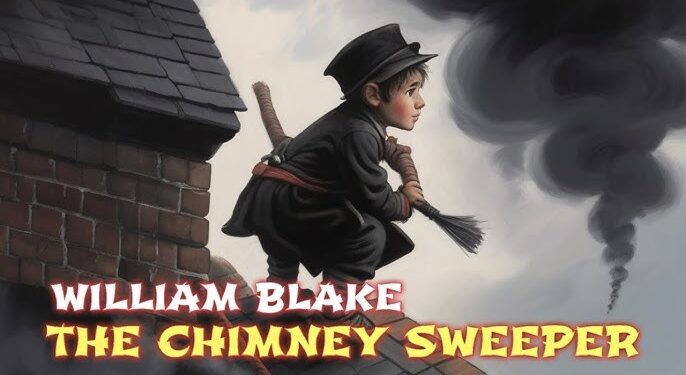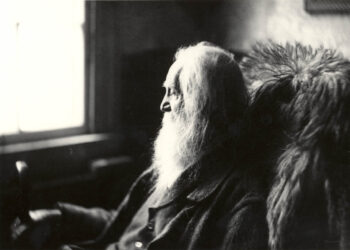Introduction
The Chimney Sweeper Summary With Themes By William Blake a pivotal figure in English literature and the Romantic movement, is renowned for his profound exploration of the human condition, societal norms, and the dichotomy between innocence and experience. His poem “The Chimney Sweeper,” which appears in two versions—one in Songs of Innocence (1789) and the other in Songs of Experience (1794)—addresses the harsh realities faced by child chimney sweeps in 18th-century England. Through poignant imagery and emotional depth, Blake critiques the social and religious systems that perpetuate the suffering of these children. This article provides a detailed summary, an exploration of key themes, and an analysis of “The Chimney Sweeper,” along with a comprehensive FAQ section.
Summary of “The Chimney Sweeper”
The Version from Songs of Innocence
Stanza 1: Introduction to the Speaker’s Plight
The poem opens with a young boy who introduces himself as a chimney sweeper. He recounts how, after the death of his mother, he was sold into the harsh life of a chimney sweep by his father. This stark introduction establishes the tone of innocence lost and the vulnerability of children in a cruel society.
- Lines 1-4: The boy reflects on his sorrow and loss, emphasizing the grief caused by his mother’s death. He mentions being “happy” when he was in his mother’s care, establishing a stark contrast with his current situation.The Chimney Sweeper Summary With Themes By William Blake
Read More
Stanza 2: The Nature of Work
The speaker describes the work he must do. He details the physical and emotional toll of chimney sweeping, a task that is dangerous and exhausting. Despite this, he shows remarkable resilience and a willingness to endure.
- Lines 5-8: The boy’s lament about his work highlights the harsh realities of child labor. The imagery of darkness and filth symbolizes the moral corruption of society that allows children to suffer in such conditions.
Stanza 3: The Vision of Hope
Amidst his despair, the boy finds solace in a dream. He envisions an angel who frees him from his labor and takes him to a beautiful garden, representing a place of purity and joy.
- Lines 9-12: This vision reflects the child’s yearning for freedom and escape from his grim reality. The garden symbolizes innocence, safety, and the hope for a better life beyond the immediate suffering.The Chimney Sweeper Summary With Themes By William Blake
-
The Chimney Sweeper Summary With Themes By William Blake
Stanza 4: Conclusion and Comfort
In the final lines, the speaker expresses the belief that if he leads a good life, he will be rewarded in heaven. This conveys a sense of naive faith in divine justice.
- Lines 13-16: The closing lines evoke a bittersweet acceptance of his fate. The promise of heavenly reward contrasts sharply with the grim reality of his life on earth.The Chimney Sweeper Summary With Themes By William Blake
The Version from Songs of Experience
Stanza 1: A Different Perspective
In the Songs of Experience version, Blake revisits the theme of child labor, but with a more cynical and accusatory tone. The speaker is now older, reflecting on the exploitation and hypocrisy of society.
- Lines 1-4: The speaker expresses bitterness about the state of the world, emphasizing the betrayal of innocence by adults and the indifference of society towards child labor.
Stanza 2: Critique of Religion
The second stanza highlights the role of religion in perpetuating the suffering of children. The speaker confronts the notion that suffering is divinely ordained.
- Lines 5-8: The poem critiques the religious and social systems that allow for the continued exploitation of the innocent. The speaker challenges the idea that suffering leads to spiritual salvation.
Stanza 3: The Reality of Suffering
The speaker acknowledges the reality of his suffering and the lack of hope for change. This stark realization represents a loss of faith in the possibility of redemption or improvement.
- Lines 9-12: The absence of comfort and the pervasive nature of despair are emphasized. The speaker’s disillusionment highlights the harsh truth of life for chimney sweepers.
Stanza 4: Confrontation and Resolution
In the final lines, the speaker directly addresses the societal forces that perpetuate injustice. The poem ends on a note of anger and indignation rather than hope.The Chimney Sweeper Summary With Themes By William Blake
- Lines 13-16: The call for accountability challenges the status quo and demands recognition of the suffering endured by children. The speaker’s voice serves as a powerful indictment of societal hypocrisy.
Read More
Key Themes in “The Chimney Sweeper”
1. Innocence vs. Experience
Blake’s Songs of Innocence and Songs of Experience juxtapose the themes of childhood innocence and the harsh realities of adult life. The first version of “The Chimney Sweeper” presents a hopeful yet naive perspective, reflecting a child’s understanding of suffering and faith. In contrast, the second version reveals a deep disillusionment with societal structures, highlighting the loss of innocence and the painful truths of life.The Chimney Sweeper Summary With Themes By William Blake
2. Child Labor and Exploitation
A central theme of the poem is the exploitation of child labor, particularly the use of chimney sweeps in the 18th century. Blake vividly portrays the physical and emotional toll on these children, emphasizing their vulnerability and the moral failures of a society that permits such exploitation. The poem critiques the normalization of child labor and calls attention to the need for social reform.
3. Religion and Hypocrisy
Blake examines the role of religion in justifying and perpetuating suffering. In the Songs of Innocence version, the speaker expresses a naive belief in divine reward, while the Songs of Experience version critiques the hypocrisy of religious institutions that fail to address the plight of the innocent. Blake challenges the notion that suffering is inherently redemptive, advocating for a more compassionate and just society.
4. The Loss of Childhood
The poem highlights the tragic loss of childhood innocence. The young chimney sweeper’s experiences reflect a broader societal failure to protect and nurture children. Blake underscores the harsh realities faced by those who are denied the joys of childhood, portraying a world where innocence is sacrificed for economic gain.The Chimney Sweeper Summary With Themes By William Blake
5. Hope and Despair
Throughout the poem, Blake explores the tension between hope and despair. In the Songs of Innocence version, the speaker’s vision of the angel and the garden symbolizes hope and the possibility of redemption. However, the Songs of Experience version reveals a more cynical view, illustrating the pervasive despair and the absence of hope for change. This duality emphasizes the complexity of human experience and the struggle for a better life.
Symbolism in “The Chimney Sweeper”
1. The Chimney Sweep
The chimney sweep itself is a symbol of the lost innocence of childhood and the exploitation of vulnerable members of society. The character embodies the suffering endured by countless children during the Industrial Revolution.The Chimney Sweeper Summary With Themes By William Blake
2. The Angel
In the Songs of Innocence version, the angel symbolizes hope, freedom, and divine intervention. The vision of the angel offers a temporary escape from the grim realities of the speaker’s life, representing the child’s longing for protection and salvation.
3. The Garden
The garden in the poem represents an idealized vision of childhood innocence, beauty, and joy. It serves as a contrast to the harshness of the speaker’s reality and signifies the longing for a world free from suffering and oppression.
4. The Grave
In the Songs of Experience version, the grave symbolizes death and the inevitability of suffering. It serves as a reminder of the bleak fate that awaits those who are exploited and neglected by society.
5. Religion
Religion is a recurring symbol in both versions of the poem, representing both hope and hypocrisy. In the Songs of Innocence version, the speaker’s faith in divine justice reflects the innocence of childhood. In contrast, the Songs of Experience version critiques religious institutions for their complicity in societal injustice.The Chimney Sweeper Summary With Themes By William Blake
Blake’s Philosophical Context
William Blake’s work is deeply rooted in the philosophical currents of his time, particularly the Romantic movement, which emphasized emotion, individual experience, and a connection to nature. Blake was critical of the Enlightenment’s rationalism and the societal structures that emerged from it, including organized religion and capitalism.
His exploration of the human condition reflects a belief in the importance of imagination and creativity. Blake viewed the world as a place where innocence and experience coexist, often in conflict. In “The Chimney Sweeper,” he illustrates the harsh realities faced by the vulnerable while advocating for a more compassionate and just society.
Blake’s emphasis on personal experience and the moral responsibility of individuals resonates throughout his poetry. He challenges readers to confront the societal injustices that persist and to recognize the inherent worth and dignity of every individual, particularly those marginalized and oppressed.

Conclusion
William Blake’s “The Chimney Sweeper” serves as a powerful critique of societal norms and a poignant exploration of the themes of innocence, exploitation, and the loss of childhood. Through its dual versions, the poem captures the complexity of human experience and the struggle for justice and compassion in a world often marked by suffering. Blake’s ability to evoke deep emotions and challenge social structures ensures that “The Chimney Sweeper” remains a relevant and thought-provoking work in English literature. The poem’s enduring legacy lies in its call for empathy and the recognition of the inherent dignity of all individuals, especially those who are vulnerable and marginalized.
Read More
FAQ
1. What is the main theme of “The Chimney Sweeper”?
The main themes of “The Chimney Sweeper” include the conflict between innocence and experience, the exploitation of child labor, the hypocrisy of organized religion, and the loss of childhood.
2. How does Blake depict child labor in the poem?
Blake vividly portrays child labor through the experiences of a young chimney sweep. The poem highlights the physical and emotional toll of this work, emphasizing the vulnerability and suffering of children exploited by society.
3. What is the significance of the angel in the Songs of Innocence version?
The angel represents hope, freedom, and divine intervention. The vision of the angel offers the speaker a temporary escape from the grim realities of life, symbolizing the child’s longing for protection and salvation.
4. How does the Songs of Experience version differ from the Songs of Innocence version?
The Songs of Experience version presents a more cynical and accusatory tone. It critiques the hypocrisy of society and religion, emphasizing disillusionment and despair rather than the hope found in the Songs of Innocence version.
5. What role does religion play in “The Chimney Sweeper”?
Religion serves as a symbol of both hope and hypocrisy in the poem. In the Songs of Innocence version, the speaker’s faith reflects innocence, while the Songs of Experience version critiques religious institutions for their complicity in societal injustice.
6. What does the garden symbolize in the poem?
The garden symbolizes an idealized vision of childhood innocence, beauty, and joy. It contrasts with the harshness of the speaker’s reality, representing the longing for a world free from suffering and oppression.
7. How does Blake explore the tension between hope and despair?
Blake explores hope and despair through the contrasting visions of the chimney sweeper’s experiences. The Songs of Innocence version expresses hope for divine justice, while the Songs of Experience version highlights pervasive despair and the absence of hope for change.
8. What can readers learn from “The Chimney Sweeper”?
Readers can learn about the importance of compassion, empathy, and social justice. The poem encourages reflection on the societal structures that perpetuate exploitation and suffering, advocating for the recognition of the inherent dignity of all individuals.
Read More

















